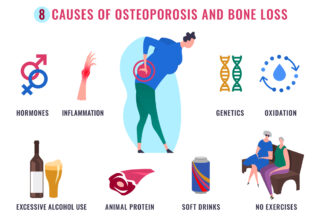
More Pain Management & Rehabilitation Articles
Prevent and Treat Osteoporosis

What Is Osteoporosis?
Bone loss is a natural part of aging in all people. But some people develop a disease called osteoporosis, and for them, bone loss is severe. Bones become fragile and break easily. Fractures can happen almost anywhere in the body, including the spine, hip, leg, pelvis, and wrist.
More women than men develop osteoporosis, but bone health should be a priority for both men and women.
Are You At Risk For Osteoporosis?
Examine your heritage:
- Are you Caucasian or Asian? These two ethnic groups are more likely to develop osteoporosis than are other ethnic groups.
- Are you thin and petite? Because small people, women in particular, have less bone mass to begin with, they are at greater risk for the disease.
- Do you have older relatives who have curvature of the spine (sometimes called “dowager’s hump”), loss of height, fractures, or chronic back pain? If so, you may have inherited a tendency toward osteoporosis.
Examine your personal health history:
- Have you passed menopause? In women, estrogen aids in the production of bone mass. At menopause, the amount of estrogen their bodies produce declines sharply.
- Have your menstrual periods stopped? Women who have had a hysterectomy, women who are high-performance athletes, and women who diet excessively or who have an eating disorder may stop having periods. These women have had a hormonal change that can cause bone loss.
- Are you taking medicines that increase the risk of osteoporosis? The most common culprits are steroid medications and high doses of thyroid hormone. Long-term use of these medicines can cause bone loss.
Examine your lifestyle:
- Smoking is linked strongly to bone loss.
- Calcium helps build and maintain healthy bone mass, and your body needs vitamin D to be able to use the calcium in your diet.
- Alcohol intake can reduce the amounts of calcium and vitamin D in your body.
- People who are confined to bed or who must wear a cast for a long time lose bone mass from lack of use. The same is true for people who do not get enough exercise in their daily lives.
Osteoporosis Is Preventable
Whether your risk of osteoporosis is high or low, lifestyle changes to prevent the disease are good for everyone.
- Eat foods that are high in calcium. Milk and other dairy products, calcium-fortified fruit juice, dark green leafy vegetables, almonds, and salmon are all good sources of calcium.
- Eat foods that help your body absorb the calcium in your diet. Fortified milk and fatty fish are good sources of vitamin D, which your body needs to be able to absorb calcium.
- Talk to your doctor or pharmacist about taking a calcium supplement. The NIH recommend these levels of calcium intake:
- 1,000 milligrams per day for 25-49-year-old premenopausal women and for 50-64-year-old postmenopausal women who take estrogen.
- 1,500 milligrams per day for 50-64 year-old postmenopausal women not taking estrogen and for all men and women over age 65.
- Make sure you get 30-60 minutes of weight-bearing exercise each week. Talk to your doctor before you begin any exercise program.
- Just 10-15 minutes of sunshine 2-3 times a week provides all the vitamin D needed.
Medications To Prevent and Treat Osteoporosis
Getting exercise and taking calcium and vitamin D are the first steps in osteoporosis prevention. For some people, a medication also may be necessary to help prevent fractures. Your doctor will prescribe the medication.
Other Articles You May Find of Interest...
- The Secrets Behind Knee Noises: When to Seek Help
- Is Custom Bracing the Secret Weapon for Your Chronic Pain Battle?
- Is Your Pain Trying to Tell You Something? Decode and Manage Your Body’s Signals
- The Benefits of Spinal Cord Stimulation in Treating Chronic Pain
- Why Choose an Orthopaedic Specialist for Spine Treatment?
- Understanding the Impact of Aging on Your Spine
- Free Yourself From Heartburn Pain

















